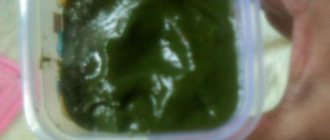Child nutrition: new foods in the diet
A 7-month-old baby's primary source of nutrition should still be breast milk or infant formula. You can diversify your baby's diet with children's fruit, vegetable, meat purees, dairy and non-dairy porridges, and children's juices. You can also slowly introduce some “adult” foods into your baby’s diet at this age.
So, let’s look at what can be included in a child’s diet at 7 months:
- porridge. It is also important to administer porridge along with breast milk. Make milk-based or dairy-free cereals; it is preferable to choose gluten-free cereals with a high iron content, for example, rice, buckwheat, oatmeal, then you can add corn and semolina porridge. Start feeding porridge with 1 teaspoon, gradually increasing the baby's portion to 150 grams;
- specialized children's nutrition. Fruit and vegetable purees also significantly diversify the baby’s menu at 7 months. To start, choose one-ingredient vegetable purees that do not cause allergies, such as potatoes, zucchini, cauliflower, and broccoli. Then, if the baby does not have allergies, you can introduce carrot, tomato, and pumpkin puree into the diet. After your baby has become familiar with vegetable purees, introduce fruit purees to his menu. Also, the choice should be made in favor of non-allergenic fruits, such as banana, apple, pear. Also introduce gradually, starting with one teaspoon, increasing the portion to 150 grams;
- meat products. At this age, you can begin to accustom your child to eating meat products. The choice should be made in favor of light, dietary types, such as chicken, rabbit, turkey, veal. Carefully read the composition of the product and make sure that this type of baby food is appropriate for the age of your baby. Meat is rich in protein, and it, in turn, is necessary for a growing, developing body, so you should not exclude meat products. Also start giving your child little by little, and if there are no negative reactions of the baby’s body to this or that type of meat, you can increase the portion to 60 grams;
- juices You can add variety to your baby's menu by adding juices. It is preferable to start by giving your baby clarified juice from apples or pears, and then gradually introducing new flavors. Choose juices from the baby food line because they do not contain sugar or other undesirable elements for your baby. It is unacceptable to give regular packaged juices “for adults”; they can be consumed no earlier than 3 years of age. It is important to introduce juices into your baby’s menu after you have accustomed your baby to cereals, vegetable purees and meat, because if you first give your child juice, he may later refuse the above-mentioned products because of their less vibrant taste;
- egg yolk. In addition to cereals and vegetable purees, egg yolk can be introduced at the age of 7 months. Just don’t be confused, you only need to give the yolk, since it is an excellent source of healthy omega-3 fats, selenium, etc. To begin with, like all other complementary foods, the product needs to be “tested” so that the baby does not have an allergy, and only after making sure In the normal reaction of the body to egg yolk, it can be introduced not as a separate product, but as an additive to cereals and purees. In addition to chicken yolk, you can try giving your child the yolk of quail eggs;
- children's cookies and crackers. At this age, some babies begin to cut their teeth, so you can introduce baby crackers and cookies into the diet, just choose a product that is not too hard so that the baby does not cut his gums and get hurt. Also carefully study the composition so that it does not contain synthetic elements that are harmful to the child’s body. The important thing is that the baby should eat solid food while sitting and strictly under adult supervision.
When your baby is used to pureed foods, you should give him more solid foods. Check out the texture options for complementary foods in the diagram below.
Complementary feeding norms for one feeding
How to dress a newborn for a walk in winter
Among the products available for introduction into complementary feeding are fermented milk dishes, vegetables and fruits. In order to instill in your child a love of proper nutrition and vegetables, it is best to postpone fruits until the eighth month of a toddler’s life.
Important! The maximum single serving should not exceed 180-200 ml. Overeating can lead to allergic reactions, abdominal pain and increased gas production.
Vegetable puree
Vegetable puree should not be thick. The optimal serving size is 200 g. You should not opt for potatoes, because the starch in its composition makes the dish sticky and difficult to swallow. The following vegetables are worth considering:
- zucchini;
- cauliflower;
- broccoli;
- pumpkin
You should not yet include beets and tomatoes in vegetable recipes for a 7-month-old baby. Beets put a particular strain on the liver and kidneys, and tomatoes can cause skin rashes.
Baby and fruits and vegetables
Fruit puree
It is recommended to start getting acquainted with fruits with hypoallergenic green apples and pears. You can also include bananas in your diet. The size of a full serving is 200 g. You can safely mix fruit purees with milk to facilitate digestion.
Cereal porridge
The seventh month of life allows you to get acquainted with cereals. Preference should be given to buckwheat, oatmeal or rice. They are richer than others in vitamins and microelements, and also rarely cause allergic reactions. Porridge can be prepared from regular cereals by first grinding them in a coffee grinder or blender. The easiest way is to choose special milk porridges that do not require cooking in the children's department. There is no need to add butter to the porridge.
Attention! Porridge is a dense and satisfying product, even in a diluted and thin form. Therefore, you should not worry if your baby has eaten less than 200 ml. The optimal serving size is 130 ml.
Dairy
One feeding, completely replaced with kefir, should be 150 ml. If mom adds cottage cheese to kefir, then this should be done in the following proportion: 130 ml of kefir and 50 g of cottage cheese. The ingredients are thoroughly mixed until smooth.
Juices
Every mother should know that juices contain nothing but sugar and water. Freshly squeezed juice is no exception. Therefore, it is better to give your baby a decoction of dried fruits, herbal tea or clean water. The volume is determined by thirst, usually no more than 200 ml.
Parents, dreaming of diversifying their baby’s diet, should remember the rules for introducing complementary foods and take their time. Consistent and careful introduction to new foods will ensure healthy digestion and a child's love for proper nutrition.
Daily diet
It is very important to develop a child’s diet at 7 months so that the baby gets used to this routine and you do not have problems with it in the future. But if the baby refuses food, you should not force him to eat; it is better to feed him more nourishingly at the next meal. Make a weekly menu schedule for your baby, stick to it, and build an individual diet. If possible, you can consult your pediatrician. Make changes to the menu as necessary, replace some products with others if the baby refuses something.
Breastfed
The table shows the approximate daily diet of a breastfed baby by the hour.
| Feeding time | Menu | Serving Size |
| Meal 1: 6:00 | 1) breast milk; | 1) 200 ml; |
| Meal 2: 10:00 | 1) dairy-free or milk porridge; | 1) 150 gr. |
| 2) butter; | 2) ½ tsp. | |
| 3) egg yolk; | 3) ¼ tsp. | |
| 4) breast milk; | 4) 50 gr. | |
| Meal 3: 14:00 | 1) fruit puree: | 1) 170 gr. |
| 2) vegetable oil; | 2) 1 tsp. | |
| 3) meat puree; | 3) 30 gr. | |
| 4) fruit children's juice; | 4) 70 gr. | |
| Meal 4: 18:00 | 1) vegetable puree; | 1) 70 gr. |
| 2) children's cookies or crackers; | 2) 1-2 pcs. | |
| 3) breast milk; | 3) 130 gr. | |
| 5th meal: 22:00 | 1) breast milk; | 1) 200 gr. |
Artificially fed
The diet of a bottle-fed baby is not very different, but you can also look at it in detail in the table below.
| Feeding time | Menu | Serving Size |
| Meal 1: 6:00 | 1) infant formula; | 1) 200 ml; |
| Meal 2: 10:00 | 1) dairy-free or milk porridge; | 1) 150 gr. |
| 2) butter; | 2) ½ tsp. | |
| 3) egg yolk; | 3) ¼ tsp. | |
| 4) infant formula; | 4) 50 gr. | |
| Meal 3: 14:00 | 1) vegetable puree: | 1) 170 gr. |
| 2) vegetable oil; | 2) 1 tsp. | |
| 3) meat puree; | 3) 30 gr. | |
| 4) fruit juice; | 4) 70 gr. | |
| Meal 4: 18:00 | 1) fruit puree; | 1) 70 gr. |
| 2) children's cookies or crackers; | 2) 1-2 pcs. | |
| 3) infant formula; | 3) 130 gr. | |
| 5th meal: 22:00 | 1) infant formula; | 1) 200 gr. |
Feeding regimen
Most pediatricians believe that infants should be fed on demand, but the interval between meals should not exceed 4 hours. Approximate feeding schedule:
- Breakfast – 6:00.
- Second breakfast or lunch – 10:00.
- Lunch – 14:00.
- Dinner – 18:00.
- Last feeding before bedtime is 22:00.
If the mother is unable to fully adhere to the schedule, it can be shifted a little. Over time, this feeding scheme will be easy to transform into 4 meals a day. It is important to distribute calories correctly: breakfast and final feeding before bed are preferably light. The maximum calorie content of meals occurs at lunch and dinner.
How much should a baby eat
At 7 months, the baby should eat an amount of food per day that is 1/8 of his body weight, excluding juices, tea, compotes, and water. Drinks are not included in this figure. On average, this comes out to 1000-1200 grams of food. Divide this gram into 5 meals, it turns out that on average a baby should eat about 200 grams of food per 1 meal. This regimen will have a beneficial effect on the baby’s digestion, and he will not be bothered by a sore tummy.
It is important to feed the baby with breast milk (or formula) in the morning, a few hours later - a second meal, which already consists of complementary foods, then lunch, dinner, and before bedtime the baby can again be fed with formula or breast milk. The last meal before bed should be lighter than the previous ones so that the child's sleep is calm and comfortable.
For convenience, it is better to create a complementary feeding calendar.
Sample daily menu for a 7 month old baby
Let's consider the menu for a seven-month-old baby for every day:
- after waking up: breast milk or infant formula, depending on whether the baby is breastfed or bottle-fed - 150 - 200 g;
- for breakfast around 10:00: porridge – 150 g; fruit baby puree – 70 g;
- for lunch around 14:00: vegetable puree or homemade broth with meat and vegetables - about 180 g; you can add 1 tsp to puree or soup. oils; 1/4 pureed egg yolk; baby juice or fruit puree - 30 g;
- for an afternoon snack around 18:00: porridge - 50 g; children's cottage cheese – 30 gr.; juice or fruit puree - 30 g; cookies - 1-2 pcs.;
- before bedtime: breast milk or infant formula – 200 g.
Feeding recommendations
The main thing to remember is that everything is purely individual. Just because your friend's child eats one thing doesn't mean your child should eat the same thing. The main rule is to adhere to the diet, some deviations are possible, because a child is a person, he may also have his own needs, he may have no appetite, you do not have to follow all the laws and rules, like in the army. But it’s also wrong to treat your baby’s nutrition with chaotic indifference. If you feel that something is wrong, it is better to contact your pediatrician.
Here are some basic recommendations:
- at this age, start introducing complementary foods, diversify the menu of a 7-month-old child with new foods;
- add solid food, cut into small cubes, to the diet so that the child learns to chew and gets used to “adult” foods;
- give preference to steaming, stewing or boiling, but do not fry;
- 1 baby meal should weigh approximately 200 grams, excluding drinks, and there are 5 meals in total, so it turns out that the baby will eat approximately 1000 grams of food per day;
- do not force your baby to eat, if he doesn’t want to eat now, he will want to in a couple of hours;
- analyze which products your child does not like and he refuses them, find alternative options with which this product can be replaced;
- The first meal after waking up and the last meal before bed should be significantly lighter than the others, as a rule, this is breast milk or infant formula in the amount of 200 grams. This regime will ensure comfortable digestion for the baby and peace of mind for the mother;
- use bright dishes with images of cartoon characters to color your baby’s meal, perhaps this will help if the child refuses to eat;
- When introducing a new dish into your child’s diet, add only one new product to it. You need to introduce your child to complementary foods in stages, and introduce each new ingredient little by little and in small doses, and not in mixed form, in order to monitor the baby’s body’s reaction specifically to the product;
- It is not recommended to give your baby water to drink while eating, only before and after meals. This recommendation concerns drinking water, not juices and compotes (they should be offered to the baby after every meal). It is better to give liquid structures in a sippy cup;
- Prepare homogeneous dishes for your baby. To do this, it will not be enough to simply mash the product with a fork; it is better to beat it with a blender so that there are no clots or lumps left, and then additionally pass it through a sieve;
- Pay attention to how your child eats and what he eats. Under no circumstances allow you to eat while lying down, it is unsafe. Only sitting and preferably in a special highchair. It is recommended to use a spoon made of certified plastic;
- It is better to introduce a new product into a child’s diet during the daytime, for lunch. By this time, the body has already “woke up” and is ready to take new food, and the mother will have the opportunity to track the baby’s reaction to this or that product until the evening;
What to do if your child has allergies
When introducing new products into a child’s usual diet, parents often encounter the phenomenon of allergies. It is necessary to exclude complementary foods that cause allergies from the baby’s menu for a month; this is a signal that the child’s body is not yet ready to accept all new dishes.
Before reintroducing complementary foods that caused an allergy into the diet, we recommend consulting with your pediatrician.
Feed your baby gradually, starting with half a teaspoon. Monitor the freshness and quality of products.
We reveal the question: Vitamin D for children: necessity and danger
Baby menu at 7 months
Many mothers ask the question: “What to feed a baby at 7 months?” The answer to this question can be obtained by studying a detailed approximate daily diet for breastfed and bottle-fed babies for every day.
Breast-feeding
Breast milk is the most useful nutritional element for a baby at this age, because the child is growing, the body must be strong and healthy, and mother’s milk contains all the necessary vitamins and minerals for the child’s health. Therefore, if possible, do not refuse to feed your baby, because no artificial milk formula can replace mother’s milk.
So, let's look at the menu for a 7-month-old baby every day. The meal after waking up and before going to bed is breast milk in an amount of approximately 200 grams. Let's look at what to feed a 7-month-old baby, an approximate menu for every day of the week.
Monday
- Breakfast: semolina porridge with pieces of fruit (150 g), cottage cheese with fruit (50 g), pear puree (50 g);
- Lunch: vegetable puree from broccoli or pumpkin (180 gr.), rabbit meat puree (70 gr.), 1/4 egg yolk, compote or baby juice without sugar (150 gr.), 1 slice of bread;
- Afternoon snack: homemade yogurt (100 gr.), buckwheat porridge (50 gr.), pear puree (50 gr.), children's cookies (1-2 pcs.).
Tuesday
- Breakfast: buckwheat porridge with zucchini (100 g), baby plum puree (50 g r.), baby cottage cheese without sugar (50 g r.);
- Lunch: soup with meatballs made from turkey meat, cabbage and potatoes with onions, carrots, herbs (200 gr.), apple and peach puree (50 gr.), 1 slice of bread;
- Afternoon snack: children's fermented baked milk (100 g), oatmeal (100 g), ½ baked apple.
Wednesday
- Breakfast: rice porridge (100 gr.), jelly (50 gr.), soft baby cottage cheese (50 gr.);
- Lunch: vegetable soup, pumpkin-zucchini (200 gr.), fish meatballs (50 gr.), children's fruit juice without sugar (50 gr.), 1 slice of bread;
- Afternoon snack: homemade yogurt (berries + kefir) (100 g), corn porridge with fruit (100 g), children's cookies.
Thursday
- Breakfast: oatmeal with berries (100 gr.), children's cottage cheese with pieces of fruit (50 gr.), chopped plums;
- Lunch: vegetable and meat puree from broccoli and turkey (200 gr.), applesauce (50 gr.), fruit juice without sugar for children (80 gr.), 1 slice of bread;
- Afternoon snack: children's fermented baked milk, buckwheat porridge (100 g), children's cookies 1-2 pcs.
Friday
- Breakfast: corn porridge with apple (100 gr.), children's cottage cheese (50 gr.), plum puree (50 gr.);
- Lunch: chicken soup with rice, carrots and onions (200 g), baby pear puree (50 g), dried fruit compote (70 g), 1 slice of bread;
- Afternoon snack: homemade yogurt made from kefir and berries (150 gr.), children's cookies (1-2 pcs.), wheat porridge (100 gr.).
Saturday
- Breakfast: buckwheat porridge with pieces of fruit (100 g), children's cottage cheese (50 g), children's fruit juice without sugar;
- Lunch: puree of pumpkin, carrots, rabbit meat (200 g), baked apple with berries, 1 slice of bread;
- Afternoon snack: children's kefir (150 g), crackers or cookies 1 piece, corn porridge (100 g), pear puree (50 g).
Sunday
- Breakfast: wheat porridge with pumpkin (100 g), children's cottage cheese with berries (50 g), berry jelly;
- Lunch: beetroot soup (180 gr.), chopped low-fat fish (50 gr.), fruit puree from apple and peach (50 gr.), dried fruit compote without added sugar (100 gr.);
- Afternoon snack: yoghurt with apple sauce (150 g), children's cookies 1-2 pcs., barley porridge (100 g).
Artificial feeding
Try to feed your baby strictly by the hour, according to the schedule. This will be better for his body, and mom will be able to plan her day without any hitches. Make and write down a menu for a 7-month-old bottle-fed baby for a week.
Attach this sheet with the written diet in a visible place, so you won’t get confused about what to cook and when. The child's breakfast will be standard - infant formula, as well as a late dinner, which will take place immediately before bedtime.
Let's look at a sample menu for a 7-month-old baby for every day.
Monday
- For breakfast at 10:00 - 150 g of rice porridge, peach and apple puree.
- For lunch, offer your child soup with meat broth, 30 g of finely chopped chicken, and plum puree.
- Afternoon snack – cottage cheese, barley porridge, cauliflower puree.
Tuesday
- On Tuesday, for second breakfast, serve corn porridge, a little stewed zucchini and cabbage.
- At 14:00 lunch consisting of vegetable cream soup, cottage cheese and prunes.
- The afternoon snack can be varied with children's cookies and fermented baked milk.
Wednesday
- Wednesday can start with buckwheat porridge and broccoli puree.
- For lunch, offer your baby vegetable soup made from cabbage and beets, and some baby cottage cheese.
- A hearty dinner of pureed meat and fruit juice will be helpful.
Thursday
- For breakfast, continue to introduce your child to porridge, rice porridge and carrot and beet puree.
- The baby will like a hearty lunch consisting of meat broth, vegetables, chopped in a blender and cookies.
- For an afternoon snack, offer fruit puree with kefir.
Friday
- For breakfast, wheat porridge, pear puree.
- Lunch of meatballs and potatoes.
- For an afternoon snack, baby cottage cheese and 1/4 egg yolk.
- For dinner, puree any fruit, some rabbit meat stewed with zucchini.
Saturday
The weekend menu may consist of your child’s favorite dishes. But don’t overuse it, remember that a regime is a regime.
Menu for a 7-month-old bottle-fed baby
The nutrition of a 7-month-old baby on artificial feeding differs slightly.
The frequency of feedings remains the same, the recommended menu looks like this:
- milk mixture (about 200 ml);
- baby porridge (up to 150 g), fruit in the form of puree (up to 80 g), juice (70 ml);
- vegetable puree (100-150 g) and meat (50 g) + half an yolk, compote from allowed fruits (50-100 ml) or juice (70 ml);
- mixture or kefir (100 ml), children's cottage cheese (30 g) and cookies;
- mixture (200 ml), can be replaced with kefir.
Of course, the list of products and the sequence of their intake may differ slightly. If a child is underweight, with the doctor's approval, a more nutritious menu can be drawn up or special formulas can be added to promote weight gain.











